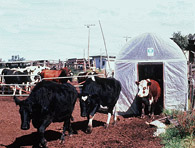
Buffalo fly trap
1992
low-tech way to rid cattle of insects
Buffalo flies are a serious problem for dairy cattle in tropical and sub-tropical Australia. Hundreds of flies bite each cow every day, causing irritation and lowering milk production. The cows develop sores and injure themselves as they scratch the bites by rubbing against trees and fences. Pesticides to control the flies are expensive and environmentally unfriendly, and flies are developing resistance to them.
In 1991 the CSIRO developed a better solution, a fly trap. The trap consists of a translucent plastic tent with a dark inner tunnel lined with brushes. When a cow walks through, the flies are brushed off. They fly upwards toward the light and become trapped in the solar-heated plastic dome. There they quickly die from desiccation (drying out) and fall to the ground, where ants eat them.
The trap has been a great success with cattle, which soon start lining up to use it. It was originally developed with financial assistance from the Dairy Research and Development Corporation, then commercialised in 1992 by Country Industries Australia. Variations of the fly trap have also been developed for beef cattle.
Who Did It?
Key Organisations
CSIRO Division of Entomology : R&D, design
Country Industries Australia Pty Ltd : manufacture
Key People
Robert Sutherst : research and development
Robert Tozer : research and development
Further Reading
'Cows give flies the slip'
Ian Anderson
New Scientist, 14 December 1991, Science & Education, p 3.
Links
NSW Department
of Agriculture
Queensland
Department of Primary Industries
|










